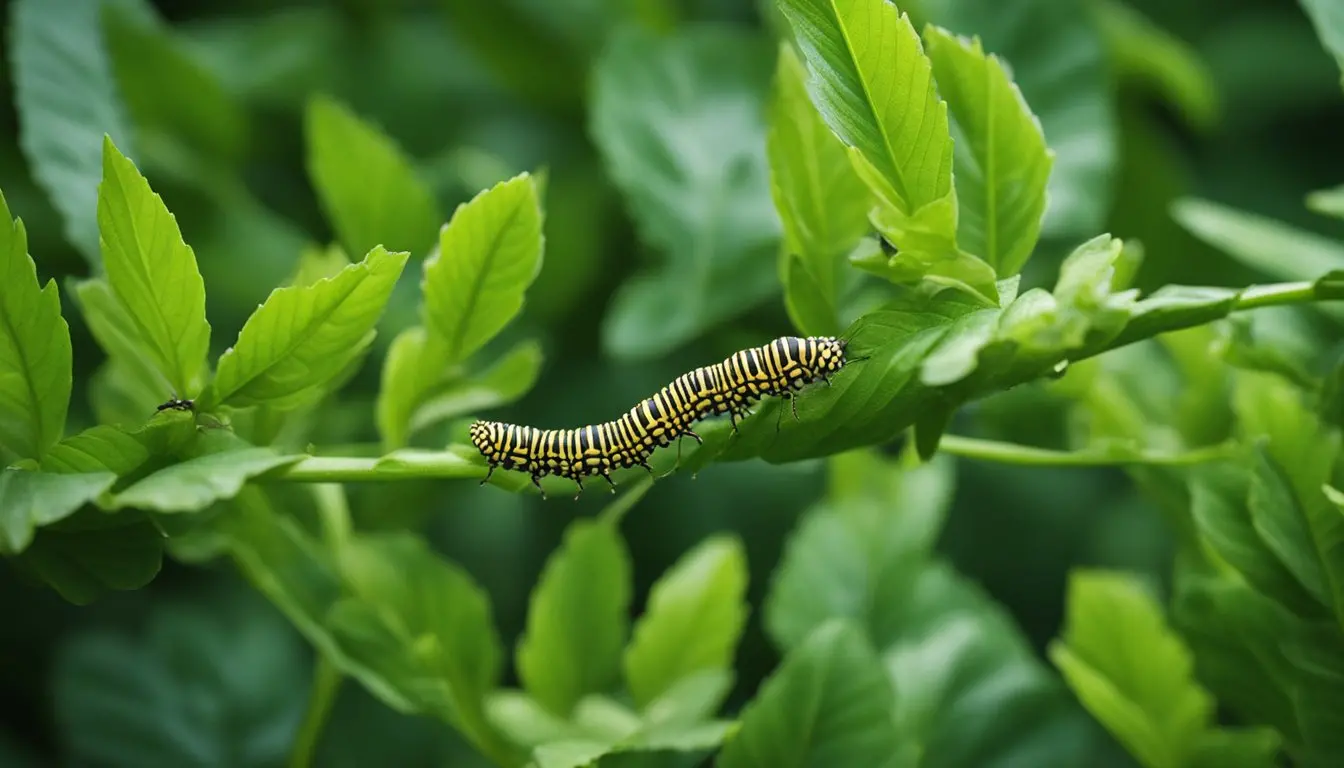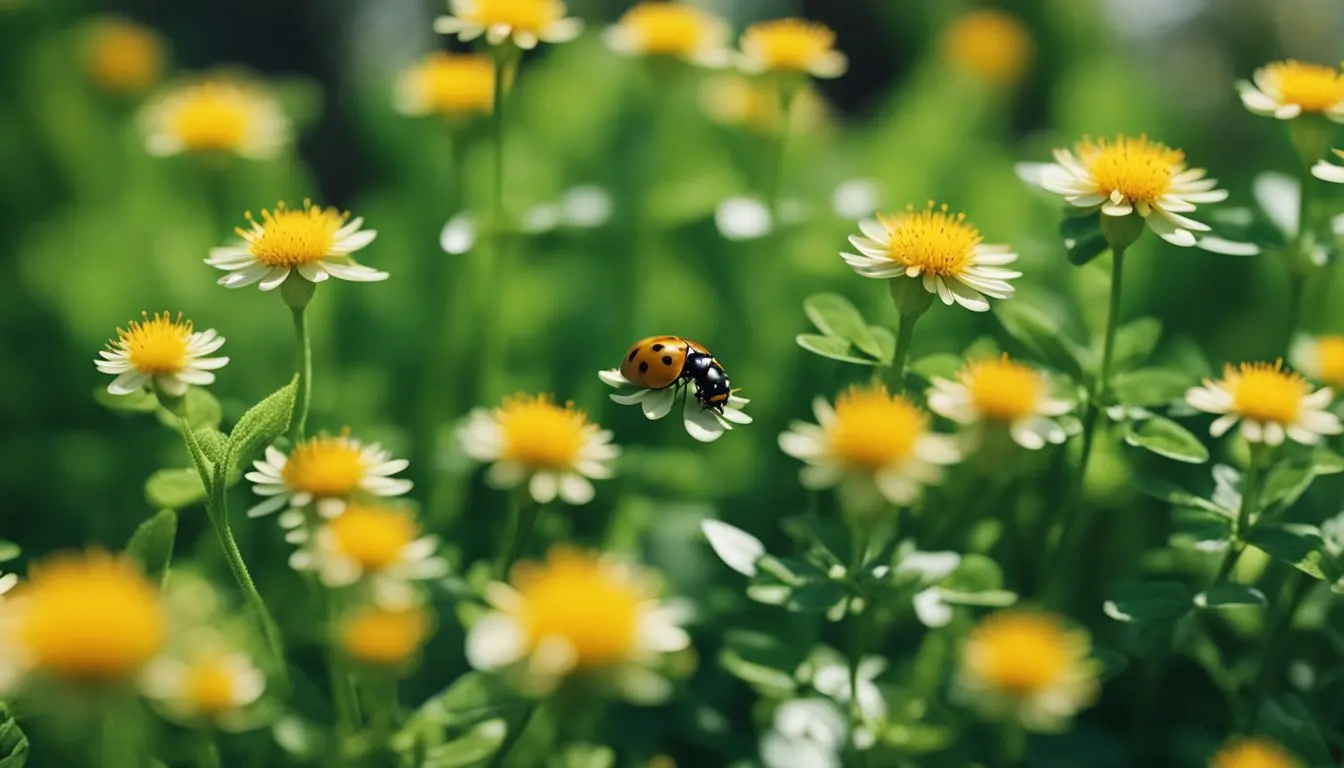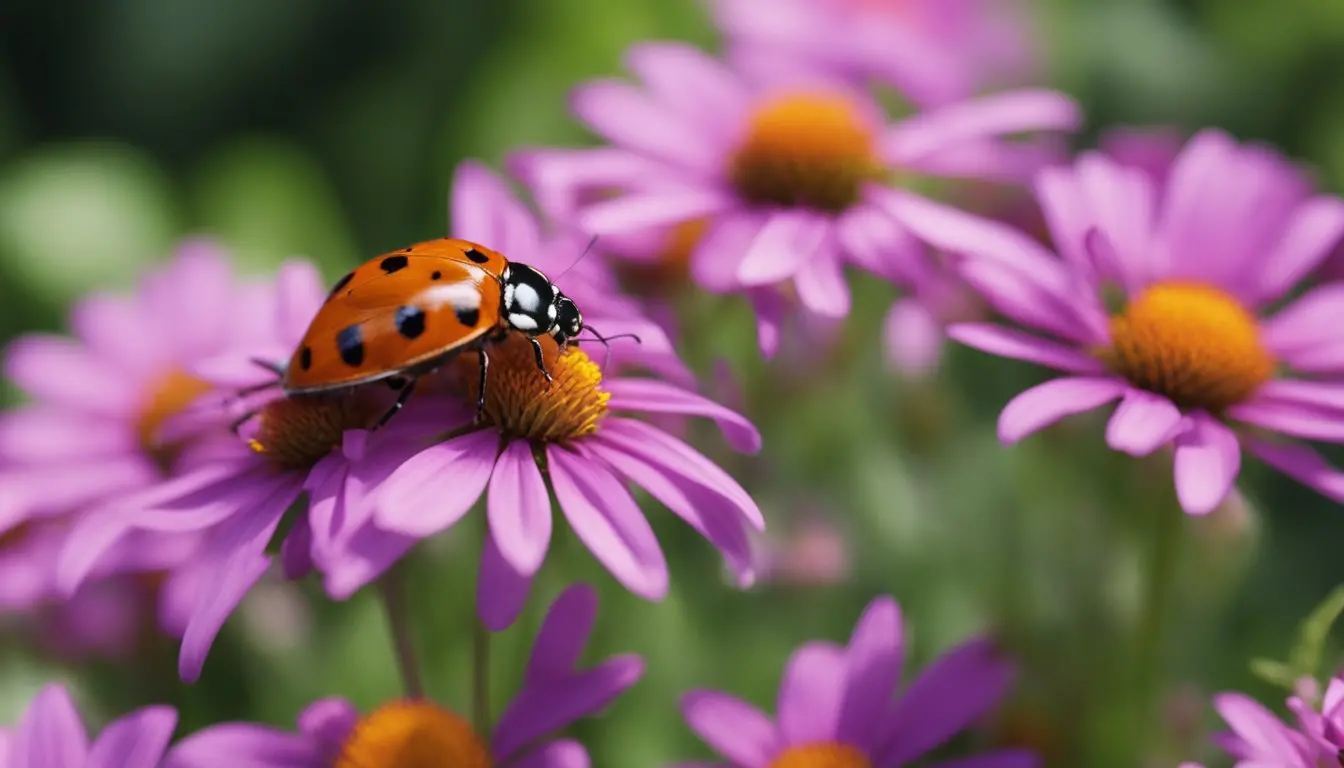Gardeners and farmers alike face the challenge of caterpillar pests, which can cause significant damage to plants and crops. Addressing this issue effectively while adhering to organic gardening principles requires an understanding of both the pests and the variety of solutions available. Organic pest management prioritizes the health of the ecosystem, aiming to control caterpillar populations without the use of synthetic chemicals which can be harmful to the environment and non-target organisms.

Managing caterpillars organically involves a combination of strategic planning and the use of natural materials and methods. This includes selecting resistant varieties of plants, practicing crop rotation, and supporting populations of natural predators. Furthermore, organic pesticides derived from natural sources, such as neem oil and Bacillus thuringiensis (Bt), can provide effective control measures without the negative impact associated with conventional synthetic pesticides. Such methods are essential in maintaining an ecological balance and ensuring the long-term sustainability of your garden or farm.
Table of Contents
Key Takeaways
- Employing organic solutions for caterpillar control protects the ecosystem while effectively reducing pest populations.
- Integrating biological controls and natural predators enhances the resilience of your garden against infestations.
- Organic approaches can be tailored to both small-scale home gardens and larger commercial agricultural settings.
The Role of Organic Pest Management

In tackling caterpillar infestations in your garden, organic pest management plays a pivotal role. It emphasizes the use of natural substances and biological controls, echoing a commitment to eco-friendly practices. This approach aids in maintaining a healthy ecosystem balance while ensuring your plants remain uncontaminated by synthetic chemicals.
Here are some core strategies:
- Biological Control: Utilize beneficial predators or parasites. Caterpillar predator animals such as birds or insects can naturally reduce the caterpillar population.
- Botanical Insecticides: Apply naturally derived insecticides like Bacillus thuringiensis (Bt), which specifically targets caterpillars without harming other insects.
- Manual Methods: Encourage daily monitoring and the removal of caterpillars by hand as a safe and immediate solution.
- Preventive Measures: Establish preventive methods like netting and traps to intercept adult moths and butterflies before they lay eggs.
Consider these steps in organic pest management as part of your routine:
- Inspection: Regularly check plants for signs of caterpillars or egg clusters.
- Identification: Know the caterpillars present in your garden to effectively target them.
- Control: Choose an organic method suited to your garden’s needs and the specific pest.
Adopting organic pest management ensures your garden thrives sustainably. It offers peace of mind, aligning with an environmentally conscious approach to protect both your plants and local wildlife.
Understanding Caterpillar Pests
Caterpillars, the larval stage of moths and butterflies, are often found in gardens and can be significant pests. Your recognition of these creatures is crucial since they can cause extensive damage to a variety of plants. The main objective for caterpillars is to eat and grow, preparing for their transformation into adult moths or butterflies.
Identifying Caterpillars:
- Look for visible chewing marks on leaves.
- Check for silk webs or rolled leaves, which can be hiding spots.
Caterpillar Feeding Habits:
- Herbivorous: Feed mainly on leaves, sometimes flowers or stems.
- Species-specific: Some caterpillars may only target certain plant species.
When managing caterpillar infestations, consider organic control methods like the application of Bacillus thuringiensis (B.t.), which is a natural bacterium that targets only caterpillars without harming beneficial insects. Organic insecticides containing spinosad are also beneficial for caterpillar control and can be derived from naturally occurring bacteria as well.
Lifecycle Considerations:
- Egg: Female moths/butterflies lay eggs on plants.
- Larva: The stage where most feeding and growth occur.
- Pupa: Transition stage into adulthood.
- Adult: Completes the lifecycle, leading to more potential egg-laying.
Understanding these pests’ appetites, lifecycles, and behaviors is the first step toward effectively managing their presence in an eco-friendly manner. This knowledge is key to implementing timely and effective control measures to protect your plants.
Preventive Strategies for Caterpillar Control
To minimize the impact of caterpillars on your plants, a combination of planning and protective measures can be very effective. Employ these tactics early on to safeguard your garden.
Crop Rotation
By rotating your crops, you reduce the chance of caterpillar pests overwintering and infesting the same plants year after year. For instance, if you planted tomatoes in one location last season, switch to beans or another non-related crop this season to prevent tomato hornworm recurrence.
Diverse Planting
Implement a diverse planting strategy; the variety of plants may confuse pests and attract beneficial insects. Introduce plants that caterpillars find unappealing next to susceptible ones, and mix in flowering species to draw predators like predatory wasps that will hunt caterpillars.
Barriers and Repellents
Consider these physical and chemical defense mechanisms:
- Barriers: Netting or row covers can physically block mature butterflies and moths from laying eggs on your crops.
- Repellents: Certain homemade repellents, such as a spray made from peppers and garlic, deter caterpillars. Essential oils, like peppermint, can also act as a natural deterrent.
Biological Control Methods
Biological control methods offer you a way to manage caterpillar pests using natural predators and pathogens. These solutions focus on maintaining the ecological balance in your garden or farm while effectively targeting pest populations.
Beneficial Insects
Ladybugs and lacewings are natural predators of caterpillar pests. Deploying these insects in your environment can help reduce caterpillar numbers, as they feed on the eggs and larvae.
- Ladybugs: Consume vast quantities of caterpillar eggs and small larvae.
- Lacewings: Their larvae, known as aphid lions, are voracious consumers of soft-bodied pests, including caterpillar larvae.
Control caterpillars with beneficial nematodes to target foliage-feeding pests like caterpillars effectively. Nematodes infect and kill caterpillars without harming beneficial insects or the environment.
Bacterial Inoculants
Bacillus thuringiensis (Bt) is a bacterium that produces toxins harmful to caterpillars but safe for humans and wildlife. It’s available in various formulations, and you need to apply it as a spray directly on infested plants.
- Bt sprays: Dissolve in water and spray on foliage; they target the digestive systems of caterpillars, causing them to cease feeding and die.
Bt sprays, use microbes against caterpillars for an organic approach to pest control.
Fungal Agents
Fungi like Beauveria bassiana and Metarhizium anisopliae act as biopesticides that can control caterpillar populations. When applied, these fungi spores adhere to the caterpillar’s body, germinate, and penetrate its exterior, leading to the pest’s death.
- Application: Spray the spore solution onto the affected plants where caterpillars are present; fungi are a natural and effective way to keep caterpillar populations in check.
Employing biological control strategies in integrated pest management programs combines these methods with others for a holistic approach to pest control.
Organic Pesticides for Caterpillars
In your battle against caterpillar pests in the garden, organic pesticides such as Neem Oil and Pyrethrin-Based Insecticides are effective options that cause minimal harm to the environment.
Neem Oil
Neem Oil is a natural pesticide extracted from the seeds of the neem tree. It is effective against a variety of caterpillar species. When you use Neem Oil, it’s important to mix it properly—usually 2 ounces per gallon of water—for it to be effective. It works by disrupting the life cycle of the caterpillars and is safe to use on your plants.
Pyrethrin-Based Insecticides
Pyrethrin, a natural compound derived from chrysanthemum flowers, is the main ingredient in many organic insecticides. It targets the nervous system of caterpillars upon contact. You can rely on Pyrethrin to control a wide range of insect pests, including caterpillars, without harming beneficial insects like bees when used according to label instructions.
Cultural Practices for Caterpillar Management
In managing caterpillars in your garden, adopting certain cultural practices can be an effective first line of defense. These methods are non-chemical, cost-effective, and reduce the need for pesticides.
Manual Removal
Manual removal of caterpillars is a straightforward approach. You can physically inspect plants and hand-pick caterpillars. Early morning or late evening are the best times to do this because caterpillars are less active then. Place them in a bucket of soapy water to dispose of them, preventing them from returning or causing further damage.
Timely Cultivation
Timely cultivation can disrupt the life cycle of caterpillars. By tilling the soil at the right times, you can destroy caterpillar pupae before they have a chance to turn into moths and lay eggs. Cultivate your garden at the end of the growing season to expose and destroy the overwintering stages of caterpillars.
Natural Predators and Their Conservation

Effective caterpillar control often involves leveraging natural predators to help manage these pests. Your understanding and support of these predators are vital for maintaining balanced ecosystems in your gardens and landscapes.
Bird Habitat Enhancement
To bolster bird populations that feast on caterpillars, provide a variety of nesting materials and safe spaces for roosting. Birds like Warblers, Nuthatches, and Orioles are particularly beneficial. You can encourage their presence by installing birdhouses adapted to their nesting preferences and ensuring that there are plenty of native plants that offer berries and seeds.
Promoting Beneficial Insects Habitat
Beneficial insects such as spiders and parasitic wasps are crucial in controlling caterpillar numbers. You can support their habitats by planting a diverse range of flora and maintaining undisturbed patches of direct soil exposure where many ground-dwelling predators nest and forage. Products based on Bacillus Thuringiensis are effective against caterpillars while having a minimal negative impact on these beneficial predators.
Organic Solutions in Commercial Agriculture
When you manage a commercial farm, controlling caterpillar pests is crucial to protecting your crops without relying on synthetic chemicals. Organic farming enhances biological pest control potential and can be fundamentally supported by various eco-friendly strategies.
Here are several organic methods for addressing caterpillar infestations:
- Biological Control Agents: Introduce natural predators, such as certain wasps or birds, to the affected area. These predators will feed on caterpillars, reducing their population naturally.
- Bacillus thuringiensis (Bt): Use this naturally occurring bacteria which produce a toxin lethal to caterpillars. When ingested, it causes caterpillar death while being safe for humans, beneficial organisms, and the environment.
- Cultural Practices: Rotate your crops and encourage diverse planting. This disrupts the life cycle of caterpillars and makes the environment less inviting for them.
| Key Method | Description |
|---|---|
| Predatory Insects | Encourage or introduce wasps that prey on caterpillars. |
| Bt Applications | Apply Bt spores and toxins, targeting caterpillar larvae. |
| Crop Rotation | Change crops periodically to disrupt pest life cycles. |
| Habitat Diversification | Plant a mix of crops to prevent caterpillar dominance. |
| Mechanical Controls | Use barriers, such as row covers, to physically block pests. |
By integrating these organic measures, you can effectively manage pest populations and maintain your commitment to sustainable agricultural practices. Remember, the key is to use Integrated Pest Management (IPM) approaches that combine different methods for a comprehensive solution.
Home Gardening and Organic Caterpillar Strategies
When you’re dealing with caterpillars in your garden, it’s essential to approach the situation with effective and organic strategies. Here’s a simple guide to help you manage caterpillar pests:
Natural Predators
Attracting beneficial insects, such as ladybugs or lacewings, can help control caterpillar populations naturally. Planting flowers like marigolds and sunflowers can invite these allies to your garden.
Bacillus Thuringiensis (Bt)
An organic and microbiological method is using Bt sprays, which are harmless to humans and other wildlife but lethal to caterpillars. Dilute the product according to instructions, usually involving a minimal amount such as 1/2 teaspoon per pint of water, and spray your plants.
Soapy Water Spray
A mild mixture of water and organic liquid soap can deter caterpillars when sprayed directly onto plants. Ensure the soap is fully dissolved in warm water before application to avoid harming your plants.
Homemade Pepper Spray
- Ingredients:
- Fresh habanero peppers
- Garlic cloves
- Vegetable oil
- Dish soap
- Preparation:
- Puree peppers and garlic with water, add oil and soap.
(Note: Always wear gloves and eye protection while handling spicy peppers). The pepper spray mixture can be an effective repellent against caterpillars.
By incorporating these organic measures, your garden can thrive without the use of harmful chemicals, aligning with eco-friendly practices while protecting your plants from caterpillar damage.
Monitoring and Thresholds for Caterpillar Intervention
Monitoring caterpillar populations is a critical first step in organic pest management. You need to regularly inspect your crops for signs of caterpillar activity, such as the presence of larvae or damage to the leaves.
- Visual Surveys: Examine plants for caterpillars and their frass. Early detection is easier if you focus on areas where these pests commonly feed.
- Pheromone Traps: Use these to attract and count adult moths to estimate potential egg-laying activity.
Once detected, it’s important to assess whether the infestation level warrants intervention. Establishing threshold levels helps avoid unnecessary treatment and preserves beneficial insects.
For young plants or those beginning to mature, consider intervention if you observe a 10% damage level to prevent a significant impact on your crop’s quality and yield.
Thresholds for Intervention:
- Young Plants: >10% damage
- Mature Plants: Higher thresholds may be tolerated, based on crop tolerance and market standards.
Remember, organic controls such as Bacillus thuringiensis (Bt) and spinosad should be applied when caterpillars are young for maximum effectiveness.
Weekly sprayings may be necessary in heavy infestations, but always aim to minimize interventions by relying on accurate monitoring and established thresholds. Remember, the goal is to balance pest control with the health of the ecosystem.
Regulatory and Safety Considerations for Organic Solutions

When selecting organic solutions to control caterpillar pests, you must understand the regulations and safety guidelines to ensure compliance and safety.
Regulatory Compliance:
- Certification: Ensure the product is OMRI (Organic Materials Review Institute) listed or meets the National Organic Program (NOP) standards.
- Label instructions: Always adhere strictly to the application rates specified on the label.
Using Bt Sprays:
- Bacillus Thuringiensis (Bt) is a microbial insecticide recognized for its limited environmental impact and is permitted in organic farming. Products based on Bt must be used as directed to ensure safety and effectiveness.
Health and Environmental Safety:
- Non-target effects: Choose products with a low impact on non-target organisms, such as beneficial insects or pollinators.
- Residual activity: Opt for solutions that are rapidly degradable, reducing persistence in the environment.
Storage and Handling:
- Storage: Keep products in a cool, dry place away from direct sunlight and foodstuff.
- Personal protection: Use appropriate protective gear when applying treatments, including gloves and masks.
Awareness and Education:
- Training: Familiarize yourself with correct application methods and safety procedures.
- Updates: Stay informed about changes to regulations and the introduction of new practices within integrated pest management strategies in organic systems.
By adhering to these considerations, you ensure that your approach to controlling caterpillar pests is not only effective but also compliant with organic agriculture standards and safe for both you and the ecosystem.
Frequently Asked Questions
In this section, you’ll discover various organic solutions and biological methods to effectively manage and control caterpillar pests in your garden.
How can neem oil be used to control caterpillar infestations?
Neem oil acts as a natural deterrent and insecticide that disrupts the life cycle of caterpillars when sprayed directly onto affected plants. Dilute the oil with water and apply it to the foliage to prevent caterpillar infestations.
What plants can naturally deter caterpillars from my garden?
Incorporating caterpillar predator plants, such as marigolds, peppermint, and lavender, can help keep your garden caterpillar-free by attracting beneficial predators that feed on caterpillar eggs and larvae.
What are effective methods to prevent caterpillars from eating plants without using chemicals?
Manual picking of caterpillars and applying barriers like nets can prevent them from reaching your plants. Introducing natural predators, such as birds or predatory insects, is another chemical-free approach to control caterpillar populations.
Can vinegar be utilized as an effective caterpillar repellent?
A vinegar solution can act as a repellent by creating an unfavorable environment for caterpillars. However, use with caution as vinegar can harm plants if not diluted properly.
What organic strategies instantly exterminate caterpillars?
Instant extermination methods are few, but organic pesticides containing B.t. (Bacillus thuringiensis) are effective in targeting and killing caterpillars soon after ingestion, without harming other insects.
Which biological control methods are recommended for managing caterpillar populations?
Biological controls include introducing organisms that are natural enemies to caterpillars, such as predators and parasites like wasps, or using microbial insecticides such as products containing spinosad or B.t., which are derived from natural soil bacteria to target and kill caterpillars.
- Best Brush Cutter: Top 5 Models for Lawn Maintenance in 2024 - January 10, 2024
- Protecting Your Garden from Rodent Damage: Tips and Tricks - December 14, 2023
- Small Space Gardening: Transform Your Garden with Raised Beds - December 10, 2023
